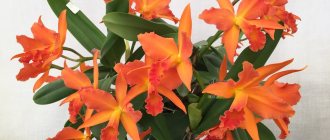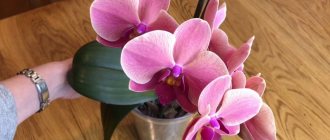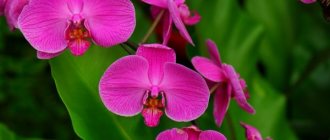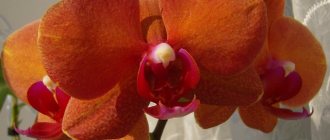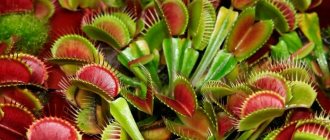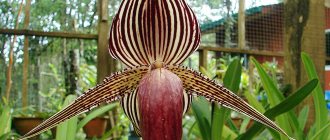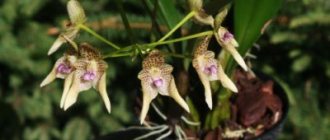It’s not for nothing that the orchid is considered the “Queen of the Tropical World.”
And if in the middle of the 20th century one could only dream of growing it at home without a greenhouse, then in modern times its varieties, one of which is phalaenopsis, the dream has turned into reality.
And hybrid forms have made growing this type of orchid in simple home conditions possible for anyone. The world of phalaenopsis is huge.
Let us describe in more detail some of the brightest representatives of the phalaenopsis variety: Pikoti, Parrot, Prima Piano, Purple that tone.
Detailed description and photo
This type of orchid belongs to the hybrid varieties of Phelaenopsis . It got its name due to the unusual type of flowers, which in their shape resemble small parrots. Phelaenopsis Parrot has an attractive and showy flower that is round and regular in shape. It has wide, oval leaves that can reach a length of up to 30 cm.
This variety has long and stiff peduncles. The scientific name of this orchid variety is Phalaenopsis "Papagayo".
Reviews from flower growers about the Parrot orchid variety
Regardless of what varietal names Parrots are purchased under, these orchids leave a good impression on gardeners:
“Last year I purchased a flowering Bee Sting. The store flowering, of course, quickly stopped, as usual after transportation. But almost immediately my “parrot” began to grow new buds on the top. After that, after a month and a half, it bloomed with three flowers. After adaptation and feeding, a new peduncle sprouted. It has been blooming uninterruptedly for a year now” (Valeria, Novorossiysk).
“I was given a baby Breezes orchid three years ago. It had three leaves and a good root, was rooted in sphagnum, but I immediately transplanted it into bark with flint. Bloomed within a year. I can say that in my collection this is the only phalaenopsis that constantly produces several flower stalks. Powerful plant! (Svetlana, Tyumen).
How is it different from other types?
The Parrot variety is a standard phelenopsis, although it has some distinctive features. First of all, this concerns coloring.
Unlike most types of orchids, this variety has bright flowers with an unusual color that have significant longevity. They are able to last more than one month and only turn slightly pale.
In addition, this plant, with proper care, is capable of growing several flower stalks at once, as a result of which the orchid stands completely covered with flowers.
The Parrot orchid does not have any varieties, but this variety can very often be found in the store under names such as :
- Phalaenopsis Breezes.
- Phalaenopsis Bee Sting.
- Phalaenopsis Elegant Charm Age.
- Phalaenopsis Chiada Francis Picotee.
All of the above names are synonyms.
Description of Phalaenopsis
Pirate Picoti
A more correct name for this hybrid is “Pirate Picotee”. In the sources there is a name and phalaenopsis Pirate Pikoti.
Phalaenopsis Pirate Picoti is distinguished by its color border.
Features and external characteristics
A special feature of this type is the color edging, which is completely different from the main color. According to the characteristics, the color of the flowers is a mix.
The height of the peduncles deserves attention , reaching 90-95 cm in an adult plant.
The leaves are fleshy, dense, medium in size. Their number will be determined by the number of arrows, carriers of flowers. Usually from 3 to 6 leaves.
The number of peduncles varies depending on conditions and care - usually 2-3.
Available colors
According to the hybrid characteristics, the main color is pink-burgundy with pronounced streaks.
Depending on the conditions of detention and feeding, the color may be paler or brighter. It is possible to increase the size of burgundy stains.
But with the right content, “Pirate Picotee” is difficult to confuse with any other hybrid. Photos of pirate picoti orchids will help identify the variety in the future.
Phalaenopsis Pirate Picoti has a distinct coloration.
Features, flowering duration and dormant period
According to reviews from experienced orchidists, it blooms every six months for 2 months:
- The diameter of the flowers is usually about 8 cm;
- Flowering is lush , almost simultaneous;
- The dormant period occurs like most phalaenopsis: after flowering, during the cold season, or when the plant needs rest.
Important! Phalaenopsis do not have a pronounced state of rest.
And in this video you can watch a review of Pirate Pikoti:
Parrot
Several varieties of orchids are called parrots - Breezes, Elegant Charm Age, Chiada Francis Picotee, as a result of which there is some confusion when determining the variety. Many manufacturers try to give their name, plus sometimes a pedigree is included. There is also a variety called Pappagayo, which can also be read as Parrot.
In relation to the Parrot, the official name for the hybrid is Breezes . Sellers often get confused by labels or received documents.
Phalaenopsis Breezes.
Blooming orchid Parrot Pappagayo.
Features and external characteristics
Plant
Size at maturity - height: about 58 cm.
Growth stability is standard; green (RHS N137C) leaves and relatively normal raceme.
Energy is moderate.
Flow time. After asexual spread, 2 leaves appear at approximately 26 weeks; around 30 weeks, 3-4 leaves appear; after cold treatment for about 4-8 weeks at a temperature of about 19 ° C, about 2 peduncles with flowers appear.
Foliage
Number per plant - about 6-8 leaves are produced before flowering.
Location and mounting - half up/horizontally and on both sides.
Phalaenopsis Elegant Charm Age Bee Sting.
The general shape of the leaf is oval : the tip is slightly pointed and asymmetrical:
- Texture – Smooth and leathery;
- Mature leaf length is from 17 to 23 cm;
- Mature leaf width is about 6-8 cm;
- The thickness of a mature leaf is about 2 mm;
- Mature leaf color - upper side: RHS N137C. Internal: RHS 137C.
Leaf base - Spicy.
Peduncle
Quantity per plant - from 1 to 3:
- The number of colors in the calculation is from 10 to 20;
- Length - from 40 to 60 cm;
- Diameter - about 5 mm;
- Strength - Strong;
- Aspect - vertical;
- Texture: bare and smooth;
- Color - brown (RHS 200C) with yellow/green (RHS 146A).
Chiada Francis Picotee.
Origin story
The female or seed parent is the variety designated "Rose of King Xian", non-proprietary.
Husband or pollen parent - cultivar designated 'King Xian's Star', mutant B, generic.
Colors
The color depends on the conditions and specifics of complex fertilizers used when caring for the plant:
- Red streaks along the edges of the petals may take up more or less space along the petal;
- May be brighter or dimmer;
- The color range ranges from bright yellow to lemon, and the stains from red to burgundy;
- In general, the color is bright, rich and attracts attention.
You can appreciate how beautiful the phalaenopsis parrot is from the photo below.
Extraordinarily beautiful colors of Phalaenopsis Parrot.
Features, flowering duration and dormant period
Inflorescence Description : Straight to slightly pendulous, red inflorescence with bilateral, symmetrical flowers that open sequentially, starting with the lowest flower.
Kidneys:
- Height (from base to tip) - from 7 to 10 mm;
- Diameter (at the midpoint) - from 5 to 7 mm;
- Shape: oval/ovoid;
- Color: yellow (RHS 11C and RHS 11D) with some purple (RHS N81B).
Flowering Time: For an untreated plant (a flowering plant that has not been cold treated, where the plant is grown at 18 to 19°C for about 4 to 8 weeks after a period of about 30 weeks at 25°C), 2 clusters appear with approximately 16-20 flower buds and flowers per inflorescence.
The first flowers can be expected approximately 4-6 months after planting the plant with leaves with a diameter of 3 to 5 cm. The flowers are persistent.
Duration of flowering on the plant : from 4 to 6 months; Durability of cut flowers: not observed.
Advice! The longest possible flowering can be ensured only by observing all the requirements for care and maintenance conditions.
Aroma: odorless.
Flower : speed of opening - flowers are fully open 2-3 days after the petal and sepal are separated.
Opening orientation: tilted up and out.
The shape is the typical shape of the Phalaenopsis orchid.
Size - height: from 55 mm to 60 mm. Diameter: from 60 mm to 70 mm. Tube depth: approx. 9mm.
Petals:
- Number and location - six petals, which are threefold, overlap and are arranged in 2 turns. The petals are more pronounced than the sepals;
- Composition - the inner turn of the petals consists of 3 petals, 2 side petals and a lamellum;
- 2 lateral petals - general shape: broadly ovate, slightly triangular and slightly oblique. Apex: oval/round. Margina: solid and slightly wavy. Base: broadly ovate. Length: approx. 29 mm. Width: approx. 32 mm. Texture. Top surface: smooth and satin. surface: smooth and satin;
- Color (when fully open): Top surface: White at base (RHS NN155C). The main color is yellow (RHS 11C, some flowers RHS 14C). Top edge red/violet (RHS 70A). All red/purple spots and streaks (RHS 70A). Below the surface: base color yellow (RHS 10D). Upper edge, spots and stripes red/purple (RHS 70B).
Video story about ordering phalaenopsis Parrot by mail: And here is a review of the phalaenopsis variety PAPAGAYO:
Prima Piano
Distinctive features and external characteristics
The unique characteristics of Prima Piano are:
- White with violet color of the flower , with a violet label and fan-shaped stains at the base of violet color;
- An orchid can produce more than one inflorescence ;
- Peduncles are long, strong;
- The leaves are short and dark green.
White and purple color of the Phalaenopsis Prima Piano flower.
The size of peduncles at maturity is 35-40 cm. Before flowering, it usually forms 8-10 oval leaves with a blunt tip. The mature leaf length is 19-24 cm, width 8 cm, with a thickness of 2 mm.
The number of peduncles on one plant varies from 1 to 7, with the number of flowers on each from 5 to 13.
Story
Phalaenopsis Prima Piano is the product of a controlled breeding program carried out by inventors René Schone, in Silwege, Heemskerk, the Netherlands.
Phalaenopsis Prima Piano.
The aim of the breeding program was to develop a new variety of Phalaenopsis characterized by its attractive and unique colored flowers, economical propagation through tissue culture, rapid growth and a size suitable for packaging and delivery to market.
The new Phalaenopsis "Prima Piano" arose from a cross made by the inventor in 1998 in Silwege, Heemskerk, the Netherlands.
- The female or parent of the seed is a Phalaenopsis variety designated as Torch, non-proprietary.
- The parent of the male or pollen is a variety called Timothy Christopher, generic.
The new Phalaenopsis Prima Piano was discovered and selected by the inventor from the offspring of the said cross in a controlled environment in 2006.
Features of flowering, flowering duration and dormant period
- Appearance . An upright, slightly elevated, colored inflorescence with bilateral symmetrical flowers that open sequentially, starting with the lowest flower;
- Kidneys . Height (base to tip): 12mm to 16mm. Diameter (at midpoint): from 8 mm to 15 mm. Shape: oval. Colour: yellow/green (RHS 144A). Orientation: same as flowers (front);
- Flowering time . For an untreated plant (a flowering plant that has not been cold-treated, where the plant is grown at 18 to 19°C for about 4-8 weeks after a period of about 30 weeks at 25°C), 2 clusters appear with about 16- 20 flower buds and flowers per inflorescence.
Prima Piano.
The first flowers can be expected approximately 4-6 months after planting, with leaves ranging from 3 to 5 cm in diameter. The flowers are persistent;
- Duration of flowering - on the plant: from 4 to 6 months; durability of cut flowers: not observed;
- Aroma . No aroma;
- Flower . Speed of opening: Flowers fully open in about 2-3 days after petal and sepal are separated. Opening orientation: tilted up and out. Shape: Typical phalaenopsis shape; Size (single flowering): Height: about 58 mm. Diameter: about 60 mm. Tube depth: about 8mm;
- Petals . Number and arrangement: three petals and three sepals, which are trimeric, overlapping and arranged in 2 whorls. The petals are more pronounced than the sepals. Location: The inner curl consists of 3 petals: 2 lateral petals and a lamellum. 2 side petals:
- General shape: broadly ovoid and slightly oblique Apex: oval;
- Margin: whole and slightly wavy;
- Base: broadly ovate;
- Length: about 30mm;
- Width: about 29mm;
- Texture: top surface - smooth and satin.;
- Beneath the surface: smooth and satiny;
- Color (when fully open): Top surface - base color white (RHS NN155C). There is a violet/violet (RHS N81C) fan shape at the base. Below the surface: white (RHS NN155C) with very vague violet/violet spots (RHS N81D).
Important! There is no clearly defined state of rest in phalaenopsis.
And in this short fragment of the video you can look at the Prima Piano variety for a couple of seconds:
Purple Two Tone (Phalaenopsis “Purple two – tone”)
Features and external characteristics
"Purple two tone" is a common hybrid phalaenopsis . It does not have any special differences or unusual characteristics. It is distinguished by its peculiar purple color with a white ribbed edge.
Phalaenopsis Purple Two tone is distinguished by its unique color.
Peduncle:
- Number per plant - from 1 to 4, on average 2;
- The number of colors in the calculation is from 10 to 20;
- Length - from 40 to 60 cm;
- Diameter - about 5 mm.
Foliage:
- Amount per plant - about 6-8 leaves ;
- Positioning and mounting - half up/horizontally and on both sides;
- The general shape of the leaf is oval : the tip is slightly pointed and asymmetrical;
- Texture – Smooth and leathery;
- Mature leaf length is from 15 to 27 cm;
- Mature leaf width is about 8-12 cm;
- The thickness of the mature leaf is about 2 mm.
Duration of flowering and dormant period
Purple Two-Tone.
The average flowering duration, according to flower growers, is about 2 months and occurs two, rarely three times a year. The opening occurs gradually, starting from the bottom of the peduncle.
As already noted, there is no clearly defined dormancy state in hybrid phalaenopsis. Phalaenopsis Purple Two Tone usually goes dormant after flowering, in winter, or due to fatigue.
Problems with growing the variety: falling leaves and buds
Such problems are mainly associated with errors in creating conditions and improper care. Falling leaves, if it is not associated with disease and care, sometimes occurs due to the death of the lower old leaves.
But the main reasons are :
- Lack of lighting;
- Bright sunlight or its excess, when the foliage simply burns;
- Excess of applied fertilizers;
- Overflow;
- Diseases.
Subspecies
Phalaenopsis Purple Rain with the same color scheme - purple and white:
- But white is the predominant color;
- Purple occupies the middle of the flower;
- Flowers are 8-9 cm in size.
Purple Rain.
The remaining characteristics do not differ from “Purple then tone”.
Bloom
The first flowering begins 4-5 months after planting. If you purchased a store-bought plant with bright flowers, the next flowering may occur in one and a half or two months, after the plant adapts to new conditions.
Flowering duration is about 6 months . The plant puts out new flower stalks, or grows buds on the tops of old ones.
Flowers form in families. As a rule, one flower consists of twenty inflorescences, the diameter of which is no more than 1 cm. The color of the flowers varies from burgundy to bright yellow. Color can also change under the influence of fertilizers used by the gardener. The flowers themselves are medium-sized and oval in shape. There are purple streaks along the edges, and small purple streaks along the veins.
Description of the Parrot orchid flower
Phalaenopsis Parrot is valued for its spectacular and attractive flower, which has the following characteristics:
| Part of a flower | Description |
| sepals | Regular oval shape, same size. The main background is yellow, with white highlights at the base. There are purple streaks along the edges. Light purple streaks run along the veins. Small purple specks are scattered along the white highlights at the base. |
| petals | Wide, diamond-shaped with rounded corners. The coloring is the same as that of sepals. |
| Column | Snow-white, small. |
| Lip | Three-lobed, purple in color. The throat is white with purple specks. At the base of the blades there is a yellow “tongue” with orange dots. |
Phalaenopsis flower Parrot is medium sized. Its diameter usually does not exceed 8 cm. There is no aroma.
Parrot flowers are long-lived, some can last for more than a month. During this time they turn slightly pale, so on the same plant flowers of different ages sometimes have a more or less bright color.
Landing
Choosing a pot
To ensure that the root system receives enough sunlight, it is best to plant in a transparent pot . A ventilation and drainage system should also be installed in this container. This is necessary to prevent water from accumulating in the roots. You can also use plastic containers.
What should the soil be like?
It is also necessary to select the appropriate substrate for the orchid. It must be air and water permeable, have a low concentration of nutrients and a slightly acidic reaction.
You can also make your own soil mixture for the plant. To do this, you will need to mix finely chopped fern roots, pine bark and loose, light leaf soil in equal proportions.
How to plant?
- The roots of the seedling should be placed in a container and distributed evenly.
- Fill all the free space between the roots with substrate.
- Compact the soil well.
- Place the plant in a cool, dark place for several weeks.
Microclimate
For full development, a suitable microclimate is required. This concept includes:
- temperature regime;
- illumination;
- moisture;
- place of growth;
- substrate and fertilizing;
- correct capacity.
Humidity of air, substrate and habitat
Proper watering and irrigation are the key to crop health. The orchid does not tolerate excessive moisture in the substrate and moisture on the leaf blades and in the axils. Overfilling the substrate will lead to rotting of the root system. Failing to recognize overwatering can cause the plant to become diseased. It is important to irrigate the crop as needed as it loves moist air. After the procedure, drops of water on the leaves and in the sinuses should be removed with a dry cloth.
The orchid loves light very much, but you still need to place it at a distance from the window. The optimal option is 1 m. Also, the orchid does not tolerate drafts or exposure to heat from heating devices.
Temperature
Phalaenopsis is a heat-loving plant, but it is difficult to develop in hot conditions. It is important for the plant that the ambient temperature remains at the same level. It will be ideal if it is possible to create a climate for the culture that will be close to natural tropical conditions. The normal temperature for an orchid is 25-28°C during the day, and 18-22°C at night.
Substrate and growing container
All Phalaenopsis hybrids will require a mixture of sphagnum moss, charcoal and pine bark. You can add peat and fern roots to them. For the health of the flower, you need to take a closer look at the container in which it is contained. The pot should be transparent, with ventilation and drainage holes. This will allow the root system to develop properly and be filled with air and moisture.
Caring for a plant at home
Temperature
The optimal air temperature for this type of orchid is from 25 to 29 degrees during the day and from 18 to 22 degrees at night.
Lighting
Long daylight with diffused light is beneficial for an orchid . Avoid direct sunlight.
Watering
Watering should be done every three or four days, depending on climatic conditions.
There is no need to water the soil itself. The pot should be placed in a container of warm water for about 10-15 minutes.
Top dressing
You need to feed the orchid with fertilizers as needed. It is very important to maintain a balance here, since excess fertilizer can lead to a decrease in the orchid’s immunity.
Trimming
Pruning the Parrot orchid should be done only after it has completely bloomed . There are several ways to trim:
- First. Partially shorten the peduncle by cutting it 1.5 cm above the dormant bud.
- Second. Trim at the very base, leaving a small stump no more than 3 cm high.
Transfer
The plant should be replanted only after its root system has formed. It is also necessary to replant every 3 or 4 years. The main purpose of such a transplant is to replace the substrate, since over time it loses its beneficial properties.
Care during the flowering period
When an orchid blooms, it needs to be watered intensively. also recommended to spray the flower with a spray bottle about once a week and feed it with special fertilizers. This should be done after one watering.
What to do if it doesn't bloom?
There are many reasons that prevent an orchid from blooming. The cause may be excessive watering or too dry air. A solution of superphosphate in proportions of 20 grams per 10 liters of water will help to bring the beginning of flowering closer.
If the plant is too young, but has already sent out an arrow, then it should be broken off.
Expert advice and common mistakes
Many people complain that their orchids do not bloom well. The main mistakes are insufficient care. You need to keep an eye on Phalaenopsis to understand what it likes and what it doesn’t. It is important to frequently inspect the plant so as not to miss the development of the disease or the effects of pests. This is what prevention is all about. Experts do not recommend using drugs to stimulate flowering; this often causes irreparable harm to the plant. You need to use a drying method that will make the Phalaenopsis bloom for a long period.
How does it reproduce?
Main methods of reproduction:
- By cuttings . Harvested from peduncles by cutting off a section with a dormant bud.
- By division . Combined with transplantation. You need to use a scalpel to cut off part of the plant, along with the roots and leaves. Then it should be dried, processed and planted in a separate container.
- Children . When children with aerial roots reach up to 3.5 cm, they are separated from the mother, treated with charcoal and planted in a separate container.
Expert advice on stimulating flowering of the Parrot orchid
Some gardeners try to artificially stimulate the flowering of orchids using cytokinin paste and other hormonal stimulants. Experts do not advise abusing these means, but recommend using other techniques:
“Orchids often respond negatively to the use of hormones. If you want to stimulate flowering, it is better to give the phalaenopsis a long cool drying period for a month, and then raise the temperature, water it and feed it with fertilizer with a predominance of phosphorus.”
Yu. Lopatina, agronomist, orchid grower with 8 years of experience
It is strictly not recommended to use cytokinin paste to awaken the lateral buds of a flowering Parrot.
Prevention of various problems
The following can be done as preventative measures::
- Carefully inspect the seedlings before planting for damage and pests.
- Observe all conditions for caring for the plant.
- Treat the soil before planting with special means. You can use a solution of manganese and colloidal salt.
The Parrot Orchid, despite all its showiness and beauty, is a rather unpretentious plant. Proper care and compliance with all recommendations for growing orchids will help you grow a bright and healthy plant.
Rules of care
Proper care of Phalaenopsis consists of watering, feeding, pruning and replanting. All basic procedures must be carried out only during the dormant period, otherwise the plant will stop blooming. Fertilizing must be done with special preparations and combined with watering. Pruning the peduncle is also necessary to lay the foundation for future flowering. You need to decide on watering and irrigating the flower yourself.
A transplant is necessary in some cases, for example, in case of orchid disease. Only an adult plant is replanted. To do this, the roots are freed from the soil, distributed in a pot and filled with the mixture. Then compact it and put it in a dark place.
Plant characteristics
The height of a mature plant is 60 cm. Before flowering begins, 3-4 pairs of green leaves are formed on the bushes. Their length is 20 cm, width is 10 cm. The end of the leaf is characterized by the presence of a small pointed nose of an asymmetrical shape. The surface of the sheet is smooth, glossy.
Flowers form in families. Usually the flower consists of 20 inflorescences with a diameter of up to 1 cm. Their color varies from yellow to burgundy. It all depends on the fertilizers the gardener uses. The root system is well developed.
Preventive measures
Prevention is primarily associated with compliance with the basic rules for caring for indoor orchids. It is important to maintain regular watering and fertilizing, maintain temperature and humidity at the required level, and ensure air circulation and drainage in the pot.
When purchasing a plant, you should pay attention to its condition and carefully examine the leaves and roots for the presence of larvae and rot.
At the first signs of infection, damaged foliage is cut off and rotten roots are removed. The flower is transplanted into new soil, which is pre-disinfected along with the potted container.
Potassium permanganate (0.2 g per 1 liter of water) and colloidal salt (0.3 g per 1 liter of water) are suitable for disinfection.
